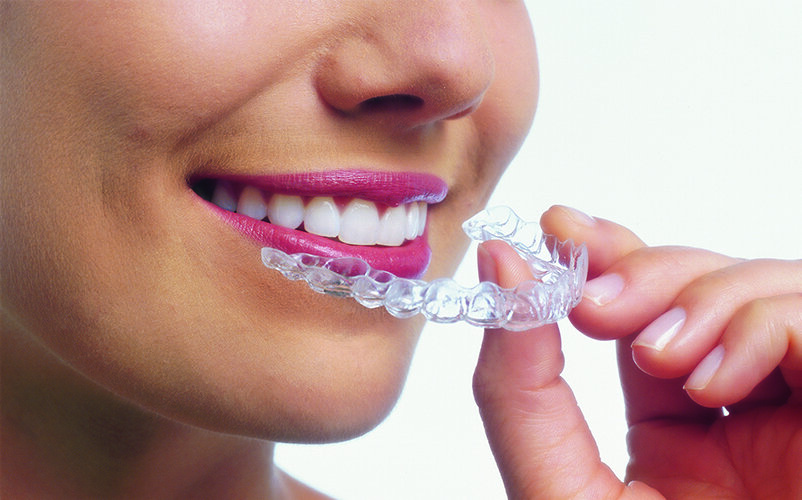What is Invisalign and How Does It Move Teeth (Part 1)?
Before 1997, practically the only way to straighten the teeth was with braces. While colored rubber bands made kids a little more excited about having treatment, adults were less enthusiastic, even if the braces were tooth colored or attached on the inside of the teeth. In 1997, a company called Align Technology introduced a technique for moving teeth using a series of customized clear aligners they called Invisalign.
Invisalign is a series of clear plastic shells that cover the teeth
Invisalign is an orthodontic system comprised of a series clear plastic shells that fit tightly around the teeth. Picture the thermoformed plastic packaging surrounding most items you purchase at retail stores. This packaging has the same size and shape as the product found inside, but is clear so that shoppers can see what they are purchasing. Most of this packaging is made by heating a thin sheet of plastic, vacuum forming it over a mold of the desired size and shape, and then allowing the plastic to cool. This is a cost-efficient way of making retail packaging because the same mold is used for every package.
Moving teeth with clear "retainers" is not new
For decades, orthodontists have used a similar thermoforming technique to make retainers that hold teeth straight after the braces are removed. A plaster model is made of the teeth and a thin plastic sheet is vacuum formed over it. Sometimes when one tooth is slightly out of alignment, the orthodontist may ask the lab technician to manually move that tooth on the model before the retainer is constructed. Then when the retainer is placed in the mouth, it fits passively around all the straight teeth while placing corrective pressure on the crooked one. Within a few days, the misaligned tooth shifts to fit into corrected position determined by the plastic shell. Although this technique works well for simple tooth movements, creating multiple models that move more than one tooth at a time was unfeasible before the development of 3D modeling and printing.
First step is the creation of a digital model of your teeth
The first step of clear aligner therapy is the creation of a digital model of the teeth. During Invisalign’s first decade, this was accomplished by digitizing a conventional impression or mold of the teeth. The availability of optical scanners has now eliminated the need for impression “goop” and digital images of the teeth are created in one step (picture the scanners used at checkout in grocery stores). Not only are optical scans more convenient for the patients, they are more accurate too.
Prescribing doctor is responsible for how the teeth move
The second step in the process is modifying the digital model to represent the desired result at the end of treatment. This is where the training and experience of an orthodontic specialist is so critical. Whether the teeth are moved with braces or plastic shells, there are principles of biology and physics that must be understood and followed. The final result will only be as good as the diagnosis and treatment plan submitted to the manufacturer by the doctor. Align Technology only makes the aligners. They do not provide diagnostic help or treatment plans. This is really important since many patients mistakenly believe that the results of Invisalign treatment will be the same no matter who provides them.
Clear aligners require training and experience for great results
The third step is to design a series of aligners that will systematically move the teeth to their final positions. There are specific movement sequences and protocols that must be prescribed by the clinician to produce predictable tooth movement. The orthodontist must understand how teeth move and which design features will be necessary to achieve those movements for each patient. Every orthodontic problem is unique and “one size does not fit all” when it comes to aligner design. Orthodontists spend hours tweaking aligner prescriptions before they are manufactured. Although non-orthodontists can order aligners for their patients, if they do not have the training experience of an orthodontist, the results will not be the same.
Invisalign aligners are manufactured according to the doctor's orders
The last step is the manufacturing of the aligners. The number of aligners is determined by the complexity of the case. The entire set of aligners are then shipped to the orthodontist for delivery to the patient.
Part 2 of this article will discuss the procedures that take place at the aligner delivery appointment.
NOTE: The author, Dr. Greg Jorgensen, is a board-certified orthodontist who is in the private practice of orthodontics in Rio Rancho, New Mexico (a suburb on the Westside of Albuquerque). He was trained at BYU, Washington University in St. Louis, and the University of Iowa in the United States. Dr. Jorgensen’s 25 years of specialty practice and nearly 10,000 finished cases qualify him an expert in two-phase treatment, extraction and non-extraction therapy, functional orthodontics, clear aligners, and multiple bracket systems (including conventional braces, Damon and other self-ligating brackets, Suresmile, and lingual braces). This blog is for informational purposes only and is designed to help consumers understand currently accepted orthodontic concepts. It is not a venue for debating alternative treatment theories. Dr. Jorgensen is licensed to diagnose and treat patients only in the state of New Mexico. He cannot diagnose cases described in comments nor can he select treatment plans for readers. Please understand that because he has over 40,000 readers each month, IT IS IMPOSSIBLE FOR HIM TO RESPOND TO EVERY QUESTION. Please read all the comments associated with each article as most of the questions he receives each week have been asked and answered previously. The opinions expressed here are protected by copyright laws and can only be used with written permission from the author.

